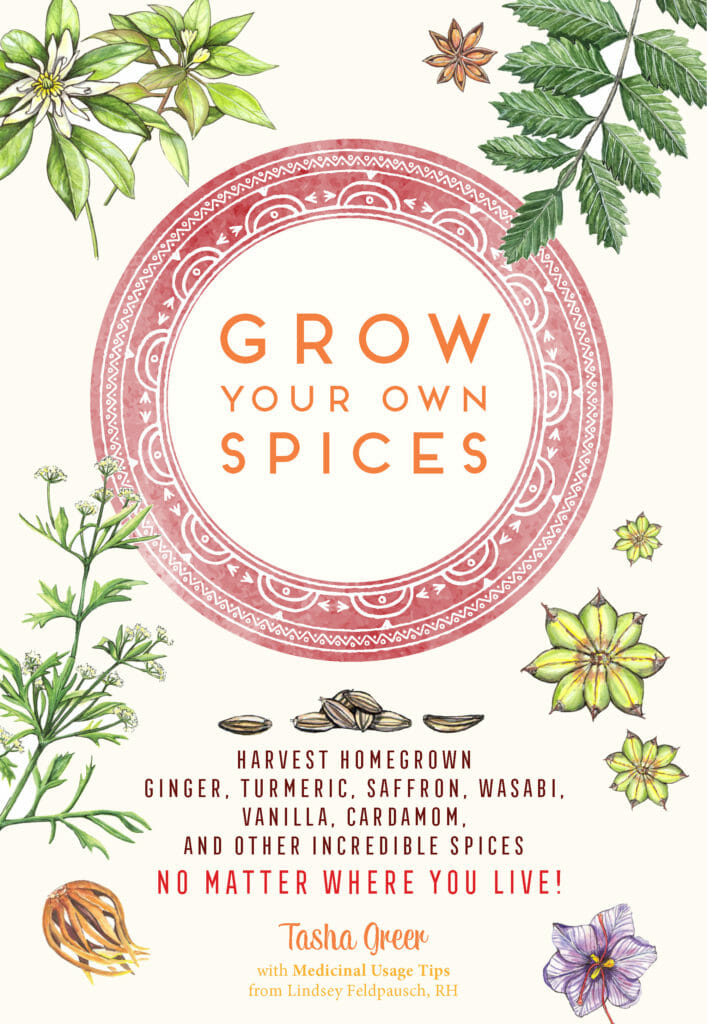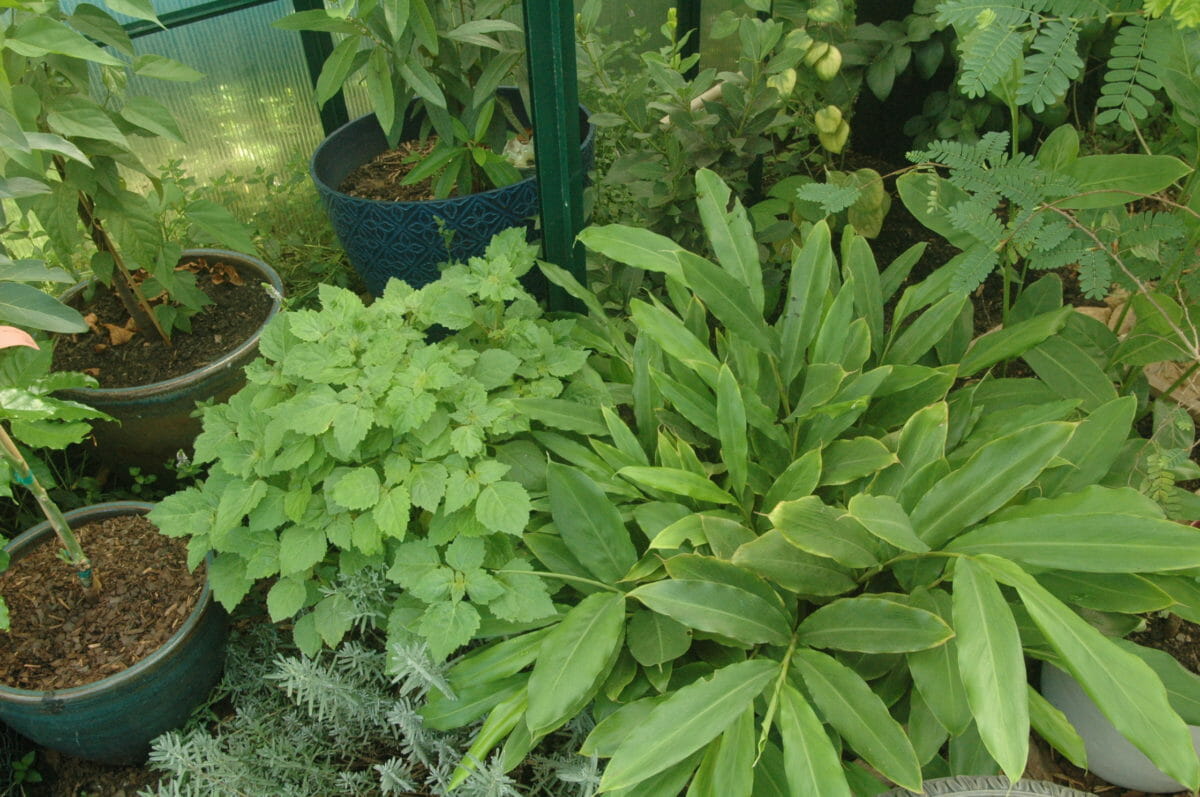How to Grow Your Own Spices
Tasha Greer has some tips for you.

Tasha Greer's new book will walk you through how to grow your own spices.courtesy Tasha Greer
Many gardeners tend small herb gardens on their window sills, but far fewer take the next step to grow their own spices.
Spice-grower and author Tasha Greer wants gardeners to know that while it takes a bit more technique to grow spices, it’s still something anyone can do. Greer wants to walk gardeners through the steps with her new book, Grow Your Own Spices, which she put together with collaborators, Lindsey Feldpausch and Greta Moore.
Greer spoke to Modern Farmer about her new book, what gardeners can do during the winter to prepare their spice gardens and whether she thinks the gardening comeback we’ve seen during the pandemic is here to stay.
The following interview is edited and condensed for clarity.

Modern Farmer: Why should people grow their own spices?
Tasha Greer: I think people should start growing their spices because you have to learn so many different garden skills to be able to get to a harvest. A lot of people start with herbs because you get quick results, but if you get into spices, you have to grow them all the way through until they seed, or pick the flowers at the perfect point. And if you’re growing underground parts, they need to be timed with increasing and decreasing daylight hours and soil temperatures. It’s those factors that cause these plants to start storing nutrients in their underground stems. So when you grow spices, you get to understand the full cycle and spectrum of a plant’s life and that translates into any aspect of gardening.
MF: We’re getting into the dead of winter. Many people are stuck in their homes due to the pandemic with little to do. What are the things people can do now to prepare to grow spices in their yard in the spring?
TG: That’s a great time to order plants and seeds because it’s kind of hard to find these things. Some plants won’t be delivered until warmer conditions, but by then it might be too late to order them as sellers might be sold out. If people can get in their spice seed orders early, they’ll be sure to have them for spring. But there are also a bunch of spices you can grow indoors entirely. Any point after the winter equinox is a good time to start them, as you’ll have increasing light in your south facing windows.
MF: It seems like there has been quite a resurgence in the popularity of gardening during the pandemic. Do you think that’s here to stay, or do you think people will abandon it once the pandemic is over?
TG: I think the momentum has been building on gardening for a long time. We went through a period when everyone wanted lawns and shrubs because they were so busy with other activities. I think people are getting tired of that kind of gardening and are coming back to wanting to have plants that need a bit more care and provide more nourishment. I think there will be some that might drop out of the gardening world, but a lot of people have gotten the gardening bug and are now forming relationships with their plants and soil. They’re not going to let go of that lightly.
I also think a lot of people seem to enjoy working at home. And when you’re at home, you can’t sit at your desk all day without the usual interruptions that you’re used to from co-workers walking up. So it’s like your garden becomes your interruption.
MF: Many people grow small herb gardens on their window sills or in their backyards. What’s the difference between herbs and spices?
TG: For me, when I’m cooking, I don’t draw much distinction. I usually think of herbs as the stuff that’s soft and cooks up easily, and I think of spices as things I have to do a bit more processing to. But when I’m talking about it from a gardening perspective, I really draw the distinction at plant maturity. With herbs, you’re always harvesting tender greens and with spices, you’re harvesting the plant parts that don’t develop until the plant has achieved sexual maturity. The thing that really distinguishes them is how long you have to grow them. It just takes a little bit more skill and know-how to grow spices.

MF: How difficult are the processing techniques for spices? And do gardeners need special equipment for this processing?
TG: I’m going to give you a homesteader answer to that one. No special equipment should be required to grow and process spices. You should be able to do all of this with things you already have. There is some technique and know-how, but you don’t need any special tools.
MF: What are the general best conditions to grow spices or does it vary greatly?
TG: It really varies. In the book, I’ve broken things down. There are definitely variations in conditions and it’s important to look at each plant individually and figure out how to give that plant what it needs. There are broad categories such as annual seed spices, cold temperature varieties and warmer season stuff. Then Mediterranean spices like drier conditions whereas tropical and subtropical ones need a bit more humidity.
On my desk, I have several things growing together. I have several things growing together: vanilla, a lemon tree, avocado and lemongrass. This is just on my desk in my office. Their light requirements are similar, but their humidity requirements are different. So I address that by using a mister. I’ll mist the vanilla, but I won’t mist the lemon. There are small adjustments you can make to grow Mediterranean with tropical spices together in the same space. You just have to know the plant and think about how to address its needs.
MF: For those that are incredibly lazy gardeners, what are some of the easiest spices to grow?
TG: Lazy gardeners need to spend at least some time up front to set up good procedures so that they can still have success. Lazy gardeners will need some sort of automated gardening system. With something like Vanilla, you could use a watering stake with a bottle on it and keep it comfortable as long as you create some humidity around it. You could plug in a humidifier that you set on a timer. That way, you can be a lazy gardener, not think about these things too much and still get good results. Most plants require regular care. Some can take irregular care, but I think most spices fall into the “regular care” category. You can be lazy, but you’ll have to do some work in advance to set up good procedures.
Follow us
This work is licensed under a Creative Commons Attribution-NoDerivatives 4.0 International License.
Want to republish a Modern Farmer story?
We are happy for Modern Farmer stories to be shared, and encourage you to republish our articles for your audience. When doing so, we ask that you follow these guidelines:
Please credit us and our writers
For the author byline, please use “Author Name, Modern Farmer.” At the top of our stories, if on the web, please include this text and link: “This story was originally published by Modern Farmer.”
Please make sure to include a link back to either our home page or the article URL.
At the bottom of the story, please include the following text:
“Modern Farmer is a nonprofit initiative dedicated to raising awareness and catalyzing action at the intersection of food, agriculture, and society. Read more at <link>Modern Farmer</link>.”
Use our widget
We’d like to be able to track our stories, so we ask that if you republish our content, you do so using our widget (located on the left hand side of the article). The HTML code has a built-in tracker that tells us the data and domain where the story was published, as well as view counts.
Check the image requirements
It’s your responsibility to confirm you're licensed to republish images in our articles. Some images, such as those from commercial providers, don't allow their images to be republished without permission or payment. Copyright terms are generally listed in the image caption and attribution. You are welcome to omit our images or substitute with your own. Charts and interactive graphics follow the same rules.
Don’t change too much. Or, ask us first.
Articles must be republished in their entirety. It’s okay to change references to time (“today” to “yesterday”) or location (“Iowa City, IA” to “here”). But please keep everything else the same.
If you feel strongly that a more material edit needs to be made, get in touch with us at [email protected]. We’re happy to discuss it with the original author, but we must have prior approval for changes before publication.
Special cases
Extracts. You may run the first few lines or paragraphs of the article and then say: “Read the full article at Modern Farmer” with a link back to the original article.
Quotes. You may quote authors provided you include a link back to the article URL.
Translations. These require writer approval. To inquire about translation of a Modern Farmer article, contact us at [email protected]
Signed consent / copyright release forms. These are not required, provided you are following these guidelines.
Print. Articles can be republished in print under these same rules, with the exception that you do not need to include the links.
Tag us
When sharing the story on social media, please tag us using the following: - Twitter (@ModFarm) - Facebook (@ModernFarmerMedia) - Instagram (@modfarm)
Use our content respectfully
Modern Farmer is a nonprofit and as such we share our content for free and in good faith in order to reach new audiences. Respectfully,
No selling ads against our stories. It’s okay to put our stories on pages with ads.
Don’t republish our material wholesale, or automatically; you need to select stories to be republished individually.
You have no rights to sell, license, syndicate, or otherwise represent yourself as the authorized owner of our material to any third parties. This means that you cannot actively publish or submit our work for syndication to third party platforms or apps like Apple News or Google News. We understand that publishers cannot fully control when certain third parties automatically summarize or crawl content from publishers’ own sites.
Keep in touch
We want to hear from you if you love Modern Farmer content, have a collaboration idea, or anything else to share. As a nonprofit outlet, we work in service of our community and are always open to comments, feedback, and ideas. Contact us at [email protected].by Modern Farmer, Modern Farmer
January 4, 2021
Modern Farmer Weekly
Solutions Hub
Innovations, ideas and inspiration. Actionable solutions for a resilient food system.
ExploreExplore other topics
Share With Us
We want to hear from Modern Farmer readers who have thoughtful commentary, actionable solutions, or helpful ideas to share.
SubmitNecessary cookies are absolutely essential for the website to function properly. This category only includes cookies that ensures basic functionalities and security features of the website. These cookies do not store any personal information.
Any cookies that may not be particularly necessary for the website to function and are used specifically to collect user personal data via analytics, ads, other embedded contents are termed as non-necessary cookies.
This was super interesting and inspired me to think beyond herbs in a kitchen garden to spices that I can start inside with some adaptations.
Thank you! Consider me inspired…
Where is she growing these plants, geographically? I don’t have warmth 24/7 so I don’t think I can easily do more tropical plants.
I would love to grow ginger and turmeric, but as root plants, and likely warmth loving as well, how can that be done indoors and in cold climates?